Israeli Work Life Post Covid
New survey of Israeli workers reveals changes in levels of satisfaction post COVID pandemic: Most workers in Israel are satisfied with their work-life balance, despite the fact that half of them work more than their official number of hours; around a third report difficulty with functioning in family life

This comprehensive survey, conducted by the Israel Democracy Institute, contains comparative data from before and after the pandemic, and sheds light on the advantages and disadvantages of working from home and of a shorter working week.
- 61% of workers are satisfied with their work-life balance, a slight increase relative to before the COVID pandemic. A larger share of self-employed workers are satisfied with this balance than of salaried workers (66% compared with 60%, respectively), and men are more satisfied than women (63% versus 56%, respectively).
- 35% of salaried workers work from home at least once a week. Working from home is most common among workers with an academic education (40%) and those with high incomes (53%), similar to the situation in 2020.
- Levels of satisfaction with work-life balance are much higher among those who work from home (65%) than among those who work only in the workplace (58%). Satisfaction is particularly high among salaried employees working from home who spread their working hours throughout the day instead of only working during official work hours (73%).
- Around 80% of the work time of salaried workers is dedicated to actual work (whether working from home or in the office). The rest of their time is given over to non-work conversations with their colleagues and to dealing with personal matters.
- At the same time, a large majority of salaried workers (79%) think that non-work conversations with colleagues are helpful for their work.
- Just over a third (36%) of workers say that their work causes difficulties in their functioning in family life, a similar proportion to that found pre-COVID. By contrast, the proportion who say they experience difficulties at work because of their family life has increased, from 23% in 2016 to 29% in 2023, seemingly because of the shift to working from home.
- Around a half of salaried employees (48%) work more than their official number of work hours.
- 47% of salaried workers cite pay as the most important characteristic of a job, up from 39% in 2018.
The Center for Governance and the Economy at the Israel Democracy Institute published an opinion survey of workers in Israel, examining their views on work-life balance and on flexibility in the labor market. The survey, led by Daphna Aviram-Nitzan, Yarden Kedar, and Roe Kenneth Portal, looked at the differences in public perceptions of the Israeli labor market and at the working conditions of Israelis in the wake of the COVID pandemic. The findings are being published ahead of the Eli Hurvitz Conference on Economics and Society, to be held for the 30th year in succession at the end of this month, with the participation of government ministers and Knesset members, ministry directors-general and other senior officials in the public sector, major figures in the business and high-tech sectors, representatives of civil society, and academics.
Daphna Aviram-Nitzan, director of the Center for Governance and the Economy at the Israel Democracy Institute (IDI): “This survey is one of a series of surveys we conduct at IDI to examine how the labor market can be helped to prepare better for the dramatic changes it faces, including the massive intrusion of digitization and artificial intelligence, the shift to a low-carbon economy, global warming, pandemics, and the rise in life expectancy which will make it possible to work several years after the current pension age. The survey indicates that despite the growth in the proportion of those working from home, this option remains a “privilege” of stronger and better educated workers: Some 47% of workers would like to work 2–3 days a week from home, while in practice only 15% currently do so. Another interesting finding worthy of attention is that men attribute more importance to pay and benefits than do women (49% of men consider this to be the most important characteristic of their job, compared with 40% of women), while women attribute more importance to self-actualization, advancement, and a pleasant working environment (36% of women versus 28% of men).”
Yarden Kedar, researcher at the Center for Governance and the Economy: “Despite the rise in working from home, this still mainly a feature of well-educated and financially strong populations. One-third of women report that they could work from home but are not allowed to by their employer, despite their desire to do so. Steps should be taken to raise awareness among employers that working from home does not reduce productivity (the time dedicated to actual work was found in the survey to be identical at home and in the office), while it increases workers’ flexibility, sense of work-life balance, and satisfaction. Working from home should not be a function of gender, financial situation, or level of education.”
Roe Kenneth Portal, researcher at the Center for Governance and the Economy: “A higher proportion of salaried employees view pay as the most important characteristic of their job now than before the COVID pandemic, mainly at the expense of self-actualization and advancement prospects. This includes younger employees. In addition, the survey found that a larger share of men than of women attaches the greatest importance to pay. The findings show that despite the changes being experienced by the labor market, a considerable proportion of workers care first and foremost about their income, and only then about flexibility or self-actualization.”
The full survey report (in Hebrew) is available here
The share of workers who are satisfied with their work-life balance stands at 61% of the total sample. There has been a gradual and steady improvement in the level of satisfaction, a trend that began before the COVID pandemic and has continued after it. The current findings reflect a continuation of this trend, following on from 60% in 2019, 60% in 2018, 59% in 2017, and 56% in 2016 (according to data from the Central Bureau of Statistics’ Social Survey).
Figure 1. Israeli workers satisfied or very satisfied with their work-life balance, 2016–2023 (main working age groups; %)
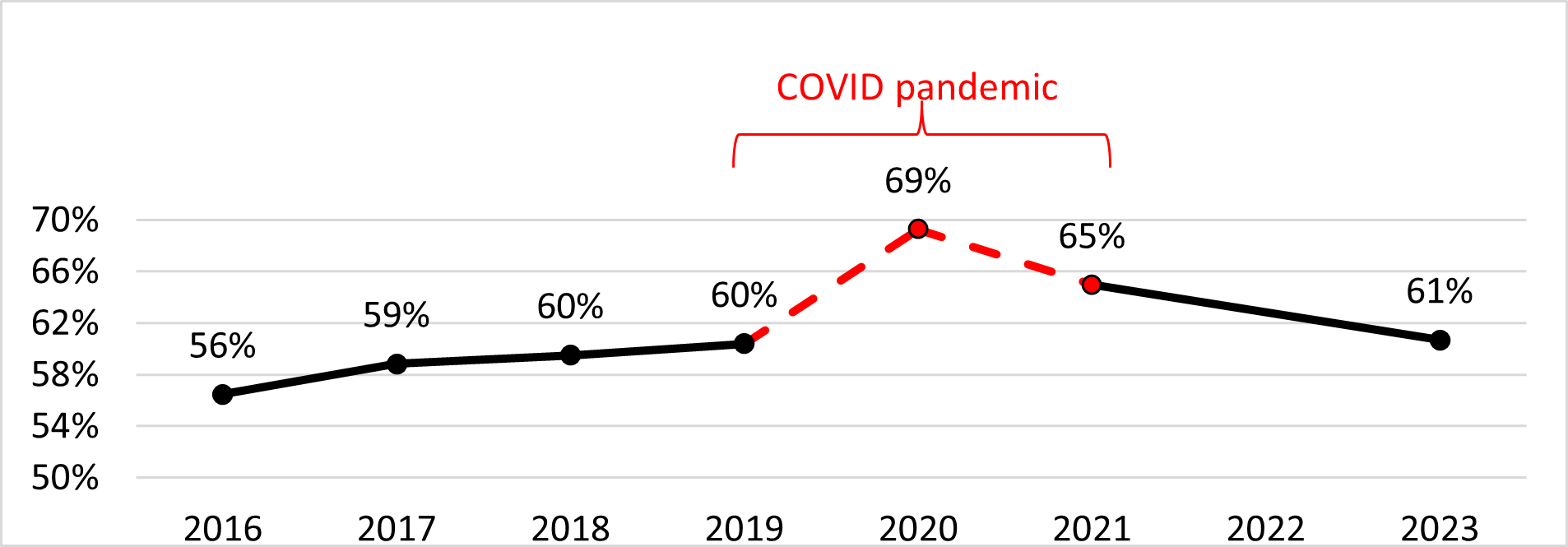
In a comparison between age groups, a larger proportion of older workers (aged 45–64) report being satisfied with their work-life balance (around 64%) than do younger workers (aged 25–44), of whom 59% say they are satisfied.
Breaking down responses by employment status reveals that self-employed workers are more satisfied (66%) than salaried workers (60%). This finding is unsurprising, given that self-employed workers can usually define their own work-life balance, whereas salaried workers are dependent on the level of flexibility allowed by their employer.
Thus, from this point on our analysis will focus exclusively on findings relating to the work-life balance of salaried workers.
Looking at gender, we find that the share of male salaried employees who report satisfaction with their work-life balance (63%) is higher than that of women (56%). This is again unsurprising, as women are usually forced to bear a larger burden of domestic labor and childcare.
The current survey reveals that 36% of workers say that in the past year, they have “sometimes” or “often” experienced difficulty in functioning in family life because of their work. This proportion has remained unchanged since 2016, when the question was last asked in the Central Bureau of Statistics’ Social Survey (see figure 2 below).
At the same time, the share of respondents who reported difficulty in functioning at work because of their family life was found to be 29% in 2023, compared with 23% in 2016. Presumably, some of this increase of 6 percentage points is due to the shift to working from home.
Figure 2. Workers who report difficulty in functioning at work/in family life “sometimes” or “often”, 2016 and 2023 (total sample; %)
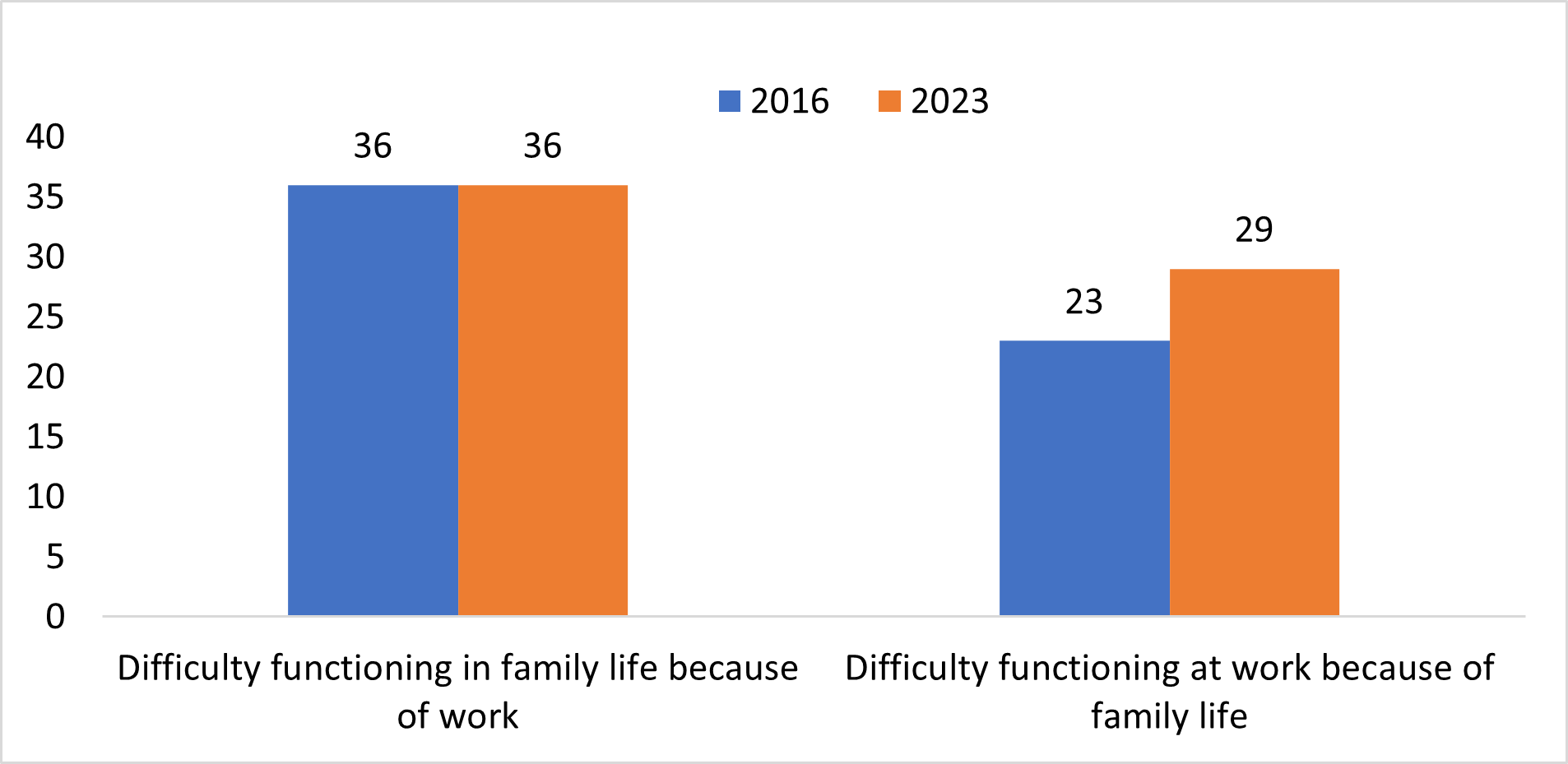
Around half of Israel’s salaried employees (48%) work more than their official number of working hours: Some 22% report working one hour a day more than their quota, on average; around 14% say they work two hours a day more; and a further 15% report working three hours or more over and above their official working hours (including 6% who work five or more extra hours per day). Similar findings emerged from IDI’s 2019 survey, conducted before the COVID pandemic.[1] At the same time, more than half of the respondents this year (52%) said that they do not work more than their official number of working hours.
In addition, 37% of all workers (both salaried and self-employed) work when on sick leave “often” or “almost always”; 28% work during vacation time “often” or “almost always”; and around 21% work on weekends at least once a month.
Compared with previous surveys on this subject carried out by the Israel Democracy Institute in 2019 (pre-COVID), there has been a slight decline in recent years in the proportion of workers (both salaried and self-employed) who work often or always during sick leave (from 40% to 37%), and a slight decline in the proportion of those who work on weekends at least once a month (from 24% to 21%). This finding tallies with the reported rise in satisfaction with work-life balance, as described above. The share of those who work often or always during vacation time has remained unchanged, at around 28%.
Figure 3. Workers who work at weekends (once a month or more), during vacation time, and during sick leave “often” to “almost always” (total sample; %)
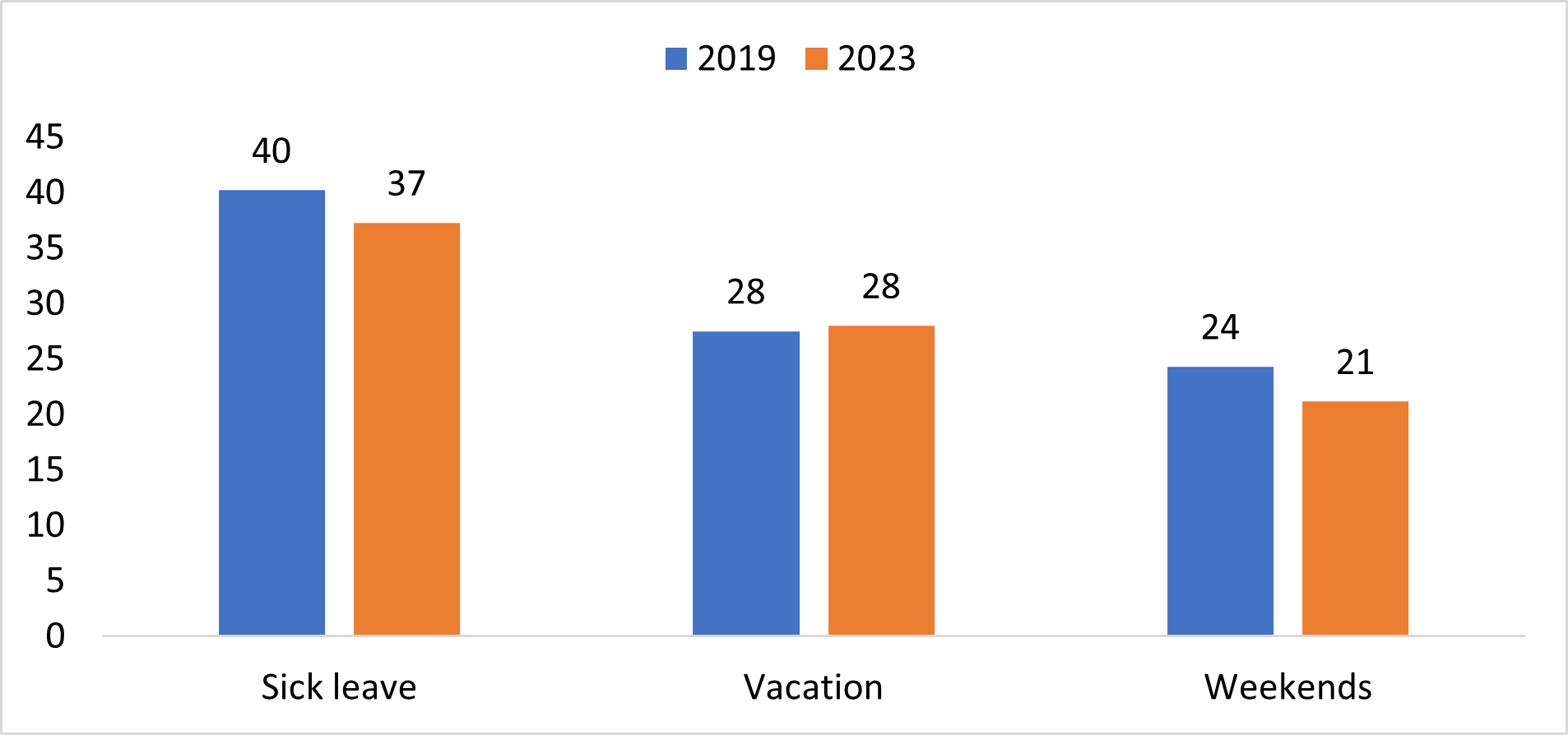
The majority of salaried employees in Israel (71%) feel that their employer shows consideration for their flexibility needs, a similar proportion to that found by the 2018 IDI survey (see figure 4).[1]
Figure 4. Feel that their employer shows consideration for their flexibility needs (salaried workers of working age; %)
[1] This finding is based on a special survey conducted by the Israel Democracy Institute in 2018, with a representative sample of salaried employees in jobs with at least 80% full-time equivalency.
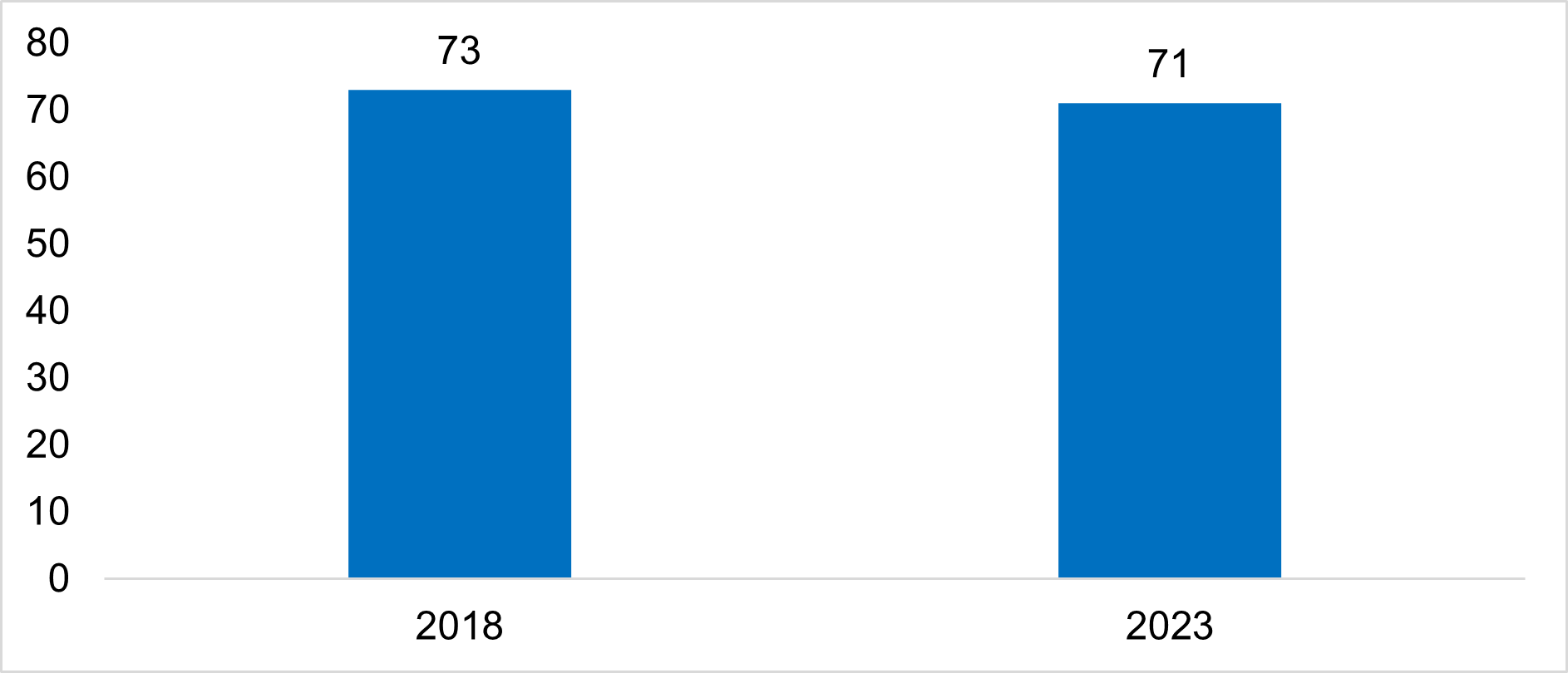
A larger share of men (75%) than of women (67%) feel that their employer shows consideration for their flexibility needs. This is in line with the finding presented above that a higher proportion of men are satisfied with their work-life balance than of women (both measures reflect respondents’ subjective self-reporting of their feelings).
In addition, the percentage of Haredi salaried employees who feel that their employer takes their flexibility needs into account (83%) is considerably higher than the equivalent share of other population groups—Arabs and non-Haredi Jews, both at 71% (see figure 5).
Figure 5. Feel that their employer shows consideration for their flexibility needs (salaried workers of working age, by population group; %)
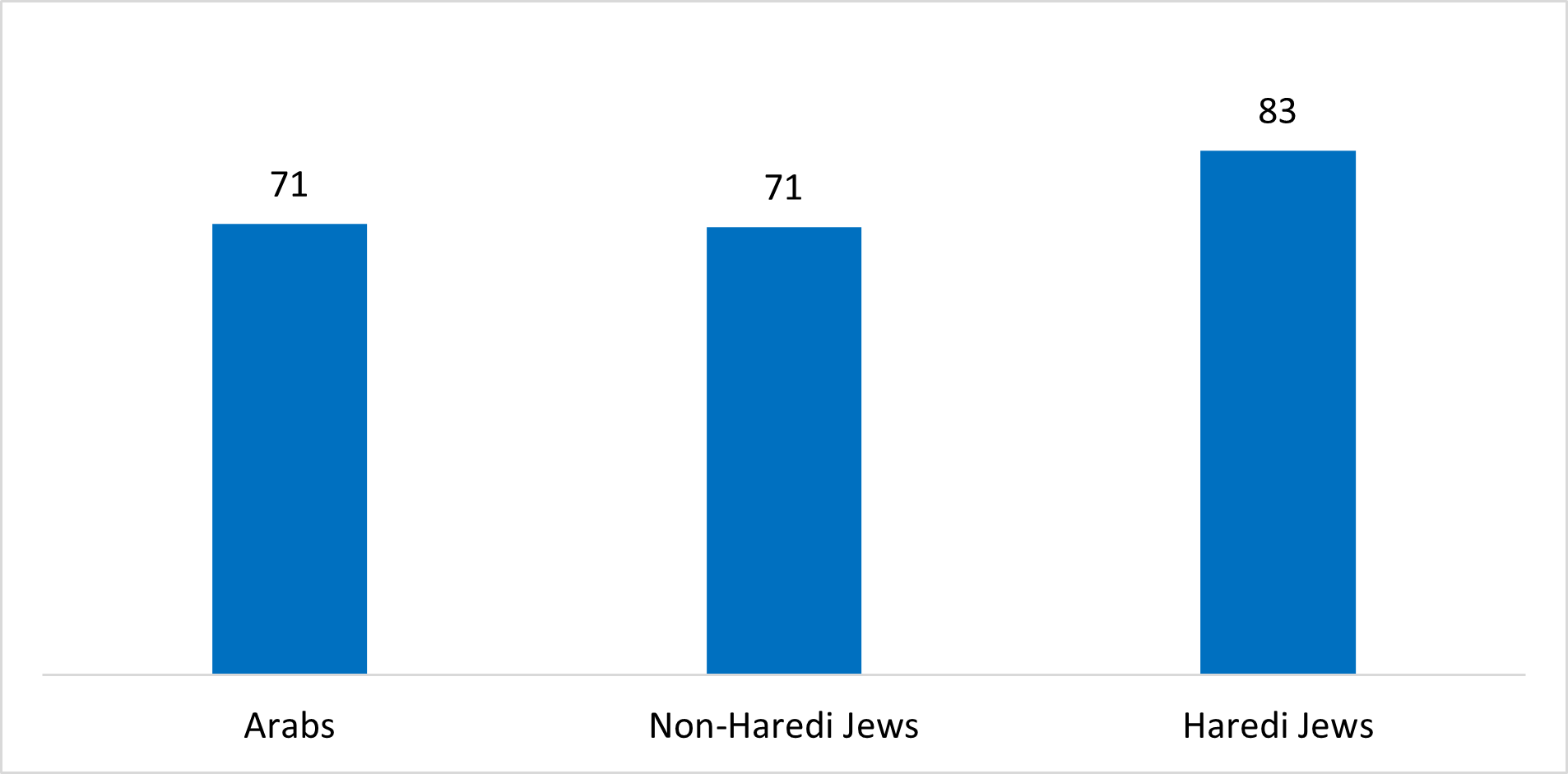
Almost half (47%) of salaried employees aged 25–64 state that pay is the most important characteristic of a job, compared with 23% who cite flexibility and freedom of action as the most important element, 15% who selected self-actualization and prospects for advancement, and 14% whose chosen response was pleasant working environment.
Figure 6. What is the most important characteristic of a job? (salaried workers aged 25–64, by age group; %)
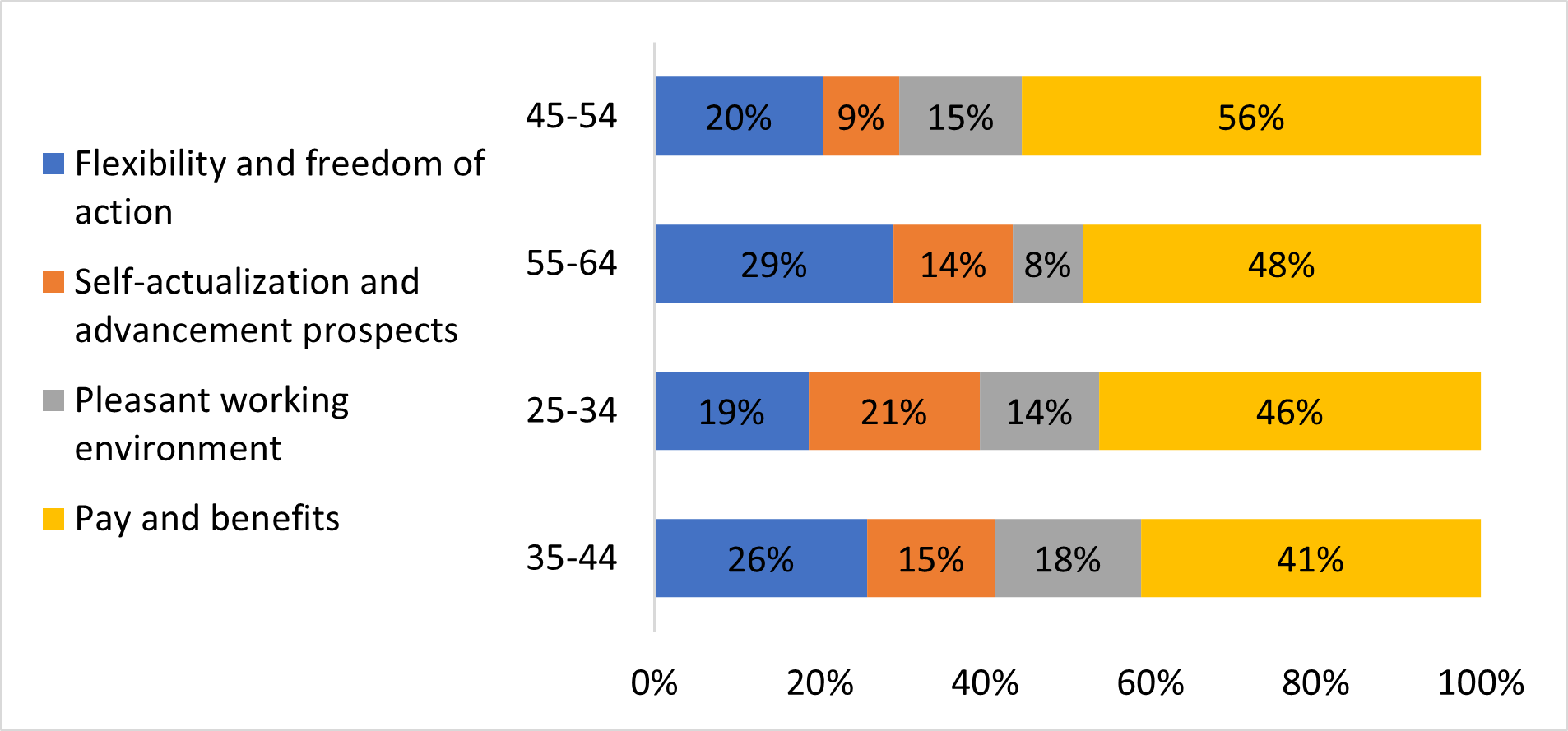
Relative to the 2018 IDI survey, the share of respondents for whom pay is the most important characteristic has grown by 8 percentage points, from 39% in 2018 to 47% in 2023 (see figure 7 below). In parallel, there has been a sharp drop of around 11 percentage points in the proportion of employees who say that self-actualization and advancement prospects are most important (from 26% in 2018 to 15% in 2023). A similar change was found among younger workers, aged 25–34 (see figure 8 below).
Presumably, this increase in importance attributed to pay is linked to rises over the last year in prices and in interest rates (which have made debt servicing more expensive, especially for mortgages), which have bolstered the priority of salary for employees.
This finding contradicts the claims commonly made in public discourse, according to which the COVID pandemic has altered the preferences of salaried employees, especially younger employees, such that flexibility, freedom of action, and self-actualization have become more important at the expense of pay and material working conditions.
Figure 7. What is the most important characteristic of a job? 2018 and 2023 (salaried workers aged 25–64; %)
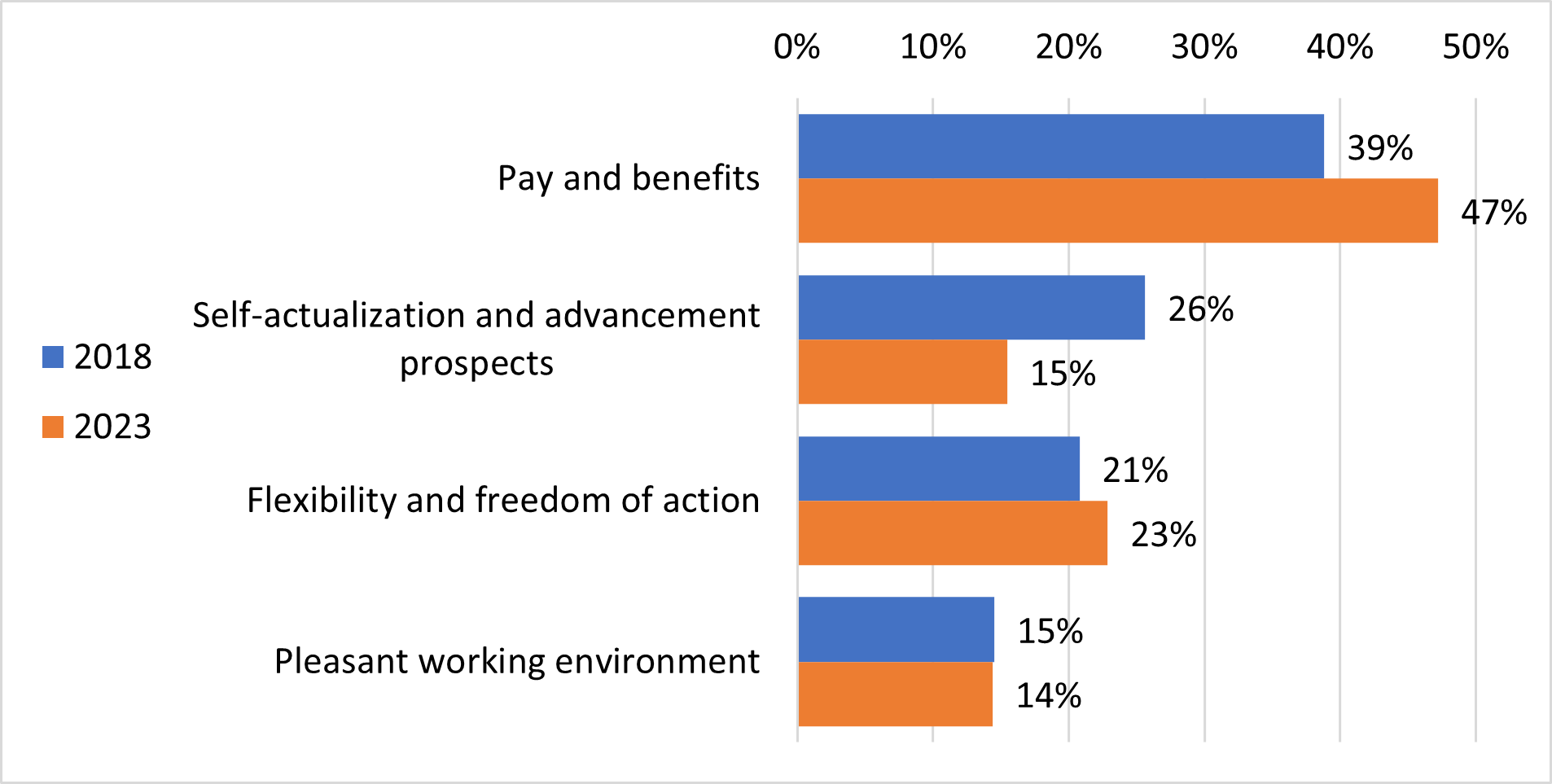
Figure 8. What is the most important characteristic of a job? 2018 and 2023 (salaried workers aged 25–34; %)

A breakdown by industry sectors (figure 9) reveals that the share of salaried employees who prioritize pay as the most important characteristic of a job is highest among workers in non-high-tech industry (54%) and lowest among workers in the public sector (44%). The proportion of those who cite flexibility and freedom of action as most important is highest in the commerce sector (31%) and lowest in high-tech (18%).
Figure 9. What is the most important characteristic of a job? (salaried workers aged 25–64, by industry sector; %)

Breaking down responses by gender (see figure 10 below) reveals that a higher proportion of men (49%) than of women (40%) consider pay and benefits to be the most important characteristic, while a higher proportion of women than of men attach greatest importance to self-actualization, advancement prospects, and a pleasant working environment.
Figure 10. What is the most important characteristic of a job? (salaried workers aged 25–64, by gender; %)
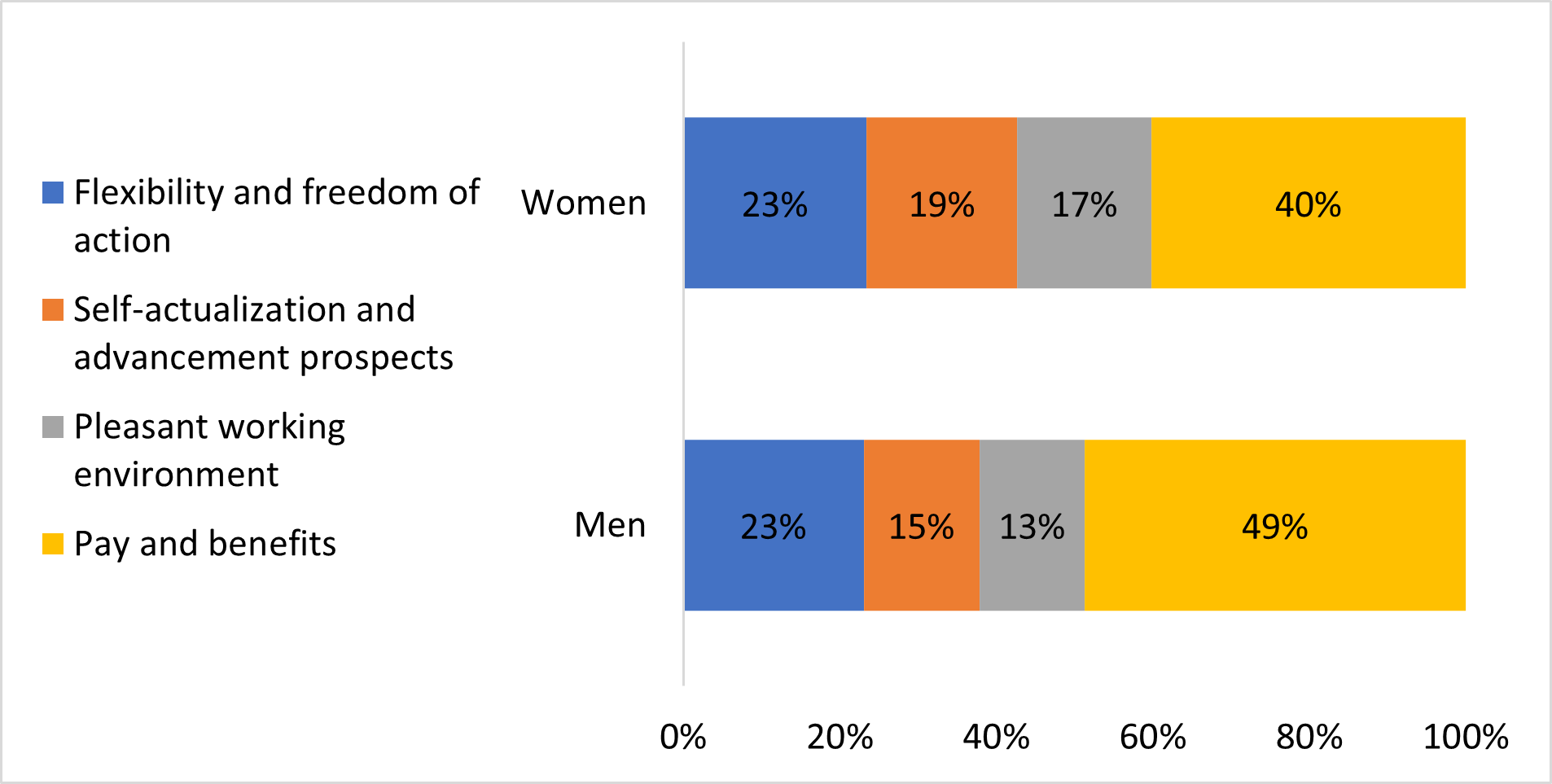
The survey also found that the proportion of employees who consider pay to be most important declines the higher their rank in the organization (see figure 11 below), from 52% among professional, production, and service workers to 40% among senior managers. On the other hand, the proportion of those who attribute the highest importance to flexibility and freedom of action rises with rank, from 20% among professional, production, and service workers to 33% among senior managers. In addition, a pleasant working environment was most widely cited as most important by workers of intermediate rank: 17% of administration workers and 16% of middle managers (compared with 7% of senior managers and 14% on average among all salaried employees).
Figure 11. What is the most important characteristic of a job? (salaried workers aged 25–64, by rank; %)

The response of self-actualization featured most prominently among employees in high-tech and in other industry (17–18%, compared with 14–15% in other sectors), and among workers in management (20%) compared with 9% of admin workers and 14% of professional workers.
A breakdown by population groups (see figure 12) reveals that the percentage of those who attach the greatest importance to pay is particularly high among Jewish employees (49%) and low among Arab employees (37%)
Figure 12. What is the most important characteristic of a job? (salaried workers aged 25–64, Jews and Arabs; %)
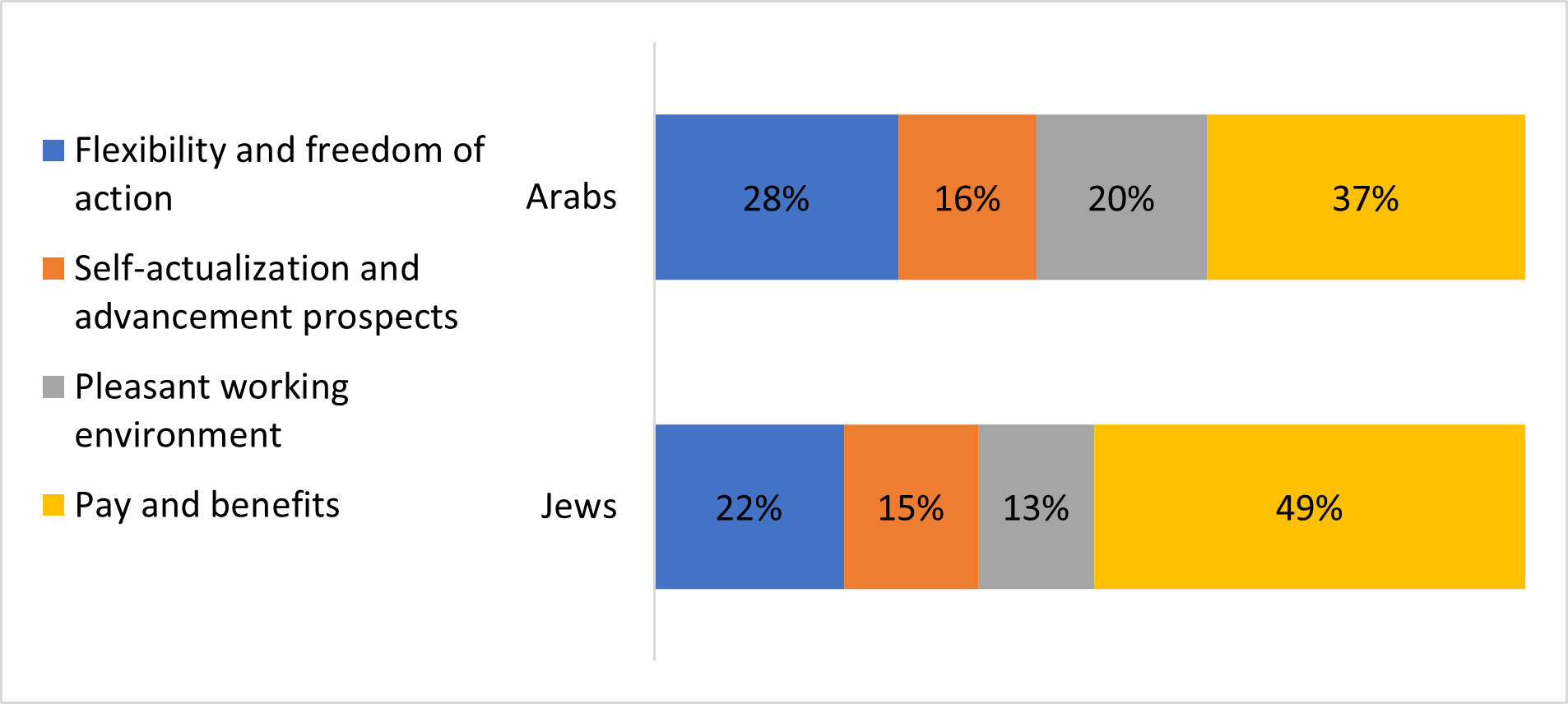
As of February 2023, around 35% of salaried employees of working age work from home at least one day a week. Compared with previous IDI surveys, this proportion is lower than it was at the height of the COVID pandemic, but much higher than it was pre-COVID (see figure 13).
Figure 13. Share of workers working from home to any extent (salaried workers and total sample, all ages; %)

Analyzing the responses by gender reveals that while a similar share of men and women work from home, the proportion of men whose occupation makes it impossible for them to work from home is much higher than the equivalent proportion of women (41% of men versus 28% of women).
On the other hand, a higher share of women report that their employer will not allow them to work from home (30%) than of men (20%). These differences stem from (among other things) the relative composition of occupations and sectors in which men and women are employed.
Figure 14. Work from home and interested in working from home (salaried workers, by gender; %)
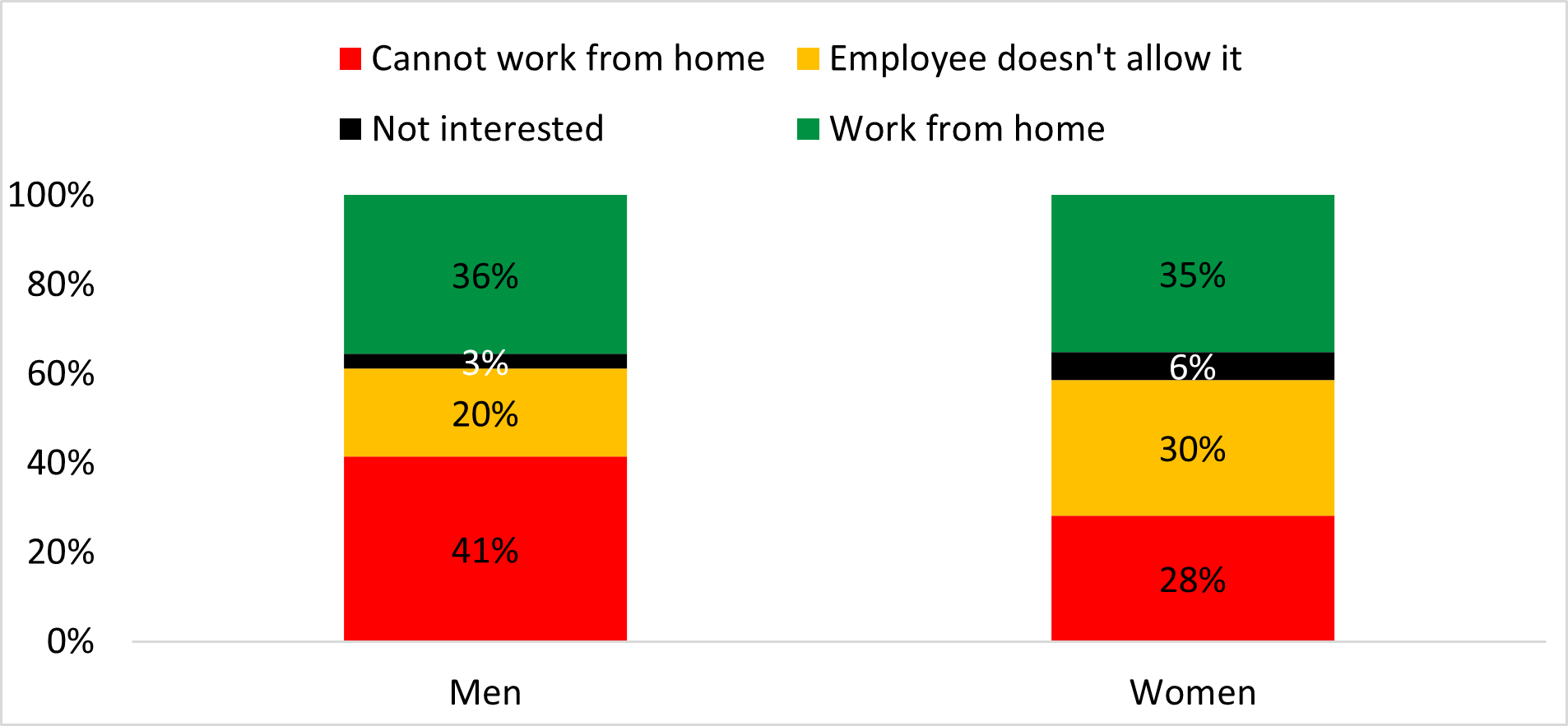
Breaking down the data by population group (see figure 15 below) reveals that the proportion of Arab salaried employees who work from home (23%) is lower than that of Jewish employees (35%). This finding is related to the fact that a much higher share of Arab employees work in occupations in which it is not possible to work from home (52%, compared with 35% of Jewish employees), and may also reflect gaps in digital literacy or in communications infrastructure.
By contrast, a relatively high percentage of Haredi employees are not interested in working from home (15%, compared with 4–8% among the other groups). This difference may stem from the difficulty of working from home when there are a relatively high number of children in the family. Among non-Haredi Jews, there is a higher proportion of workers whose employer does not allow them to work from home (26%, compared with 15–17% in the other groups).
Figure 15. Work from home and interested in working from home (salaried workers, by population group; %)
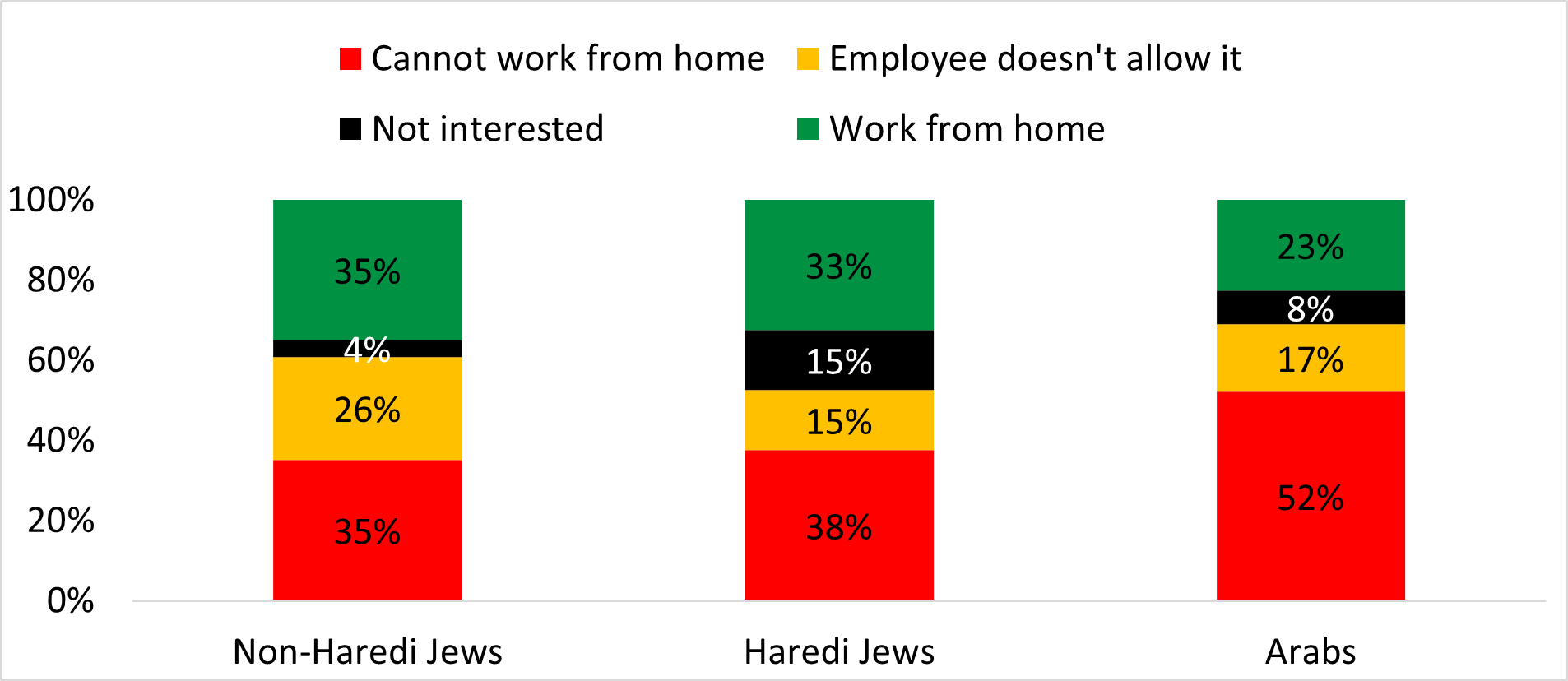
The proportion of salaried employees in a household with a total monthly income higher than NIS 25,000 who work from home (see figure 16 below) is twice as high or almost twice as high as the proportion of other income groups (53%, compared with 25–31%). These findings reinforce concerns that working from home is largely a privilege of the strongest members of the workforce—high earners with a high level of education—while the rest of the employee population is being left behind in this regard.
Figure 16. Work from home and interested in working from home (salaried workers, by monthly household income in NIS; %)
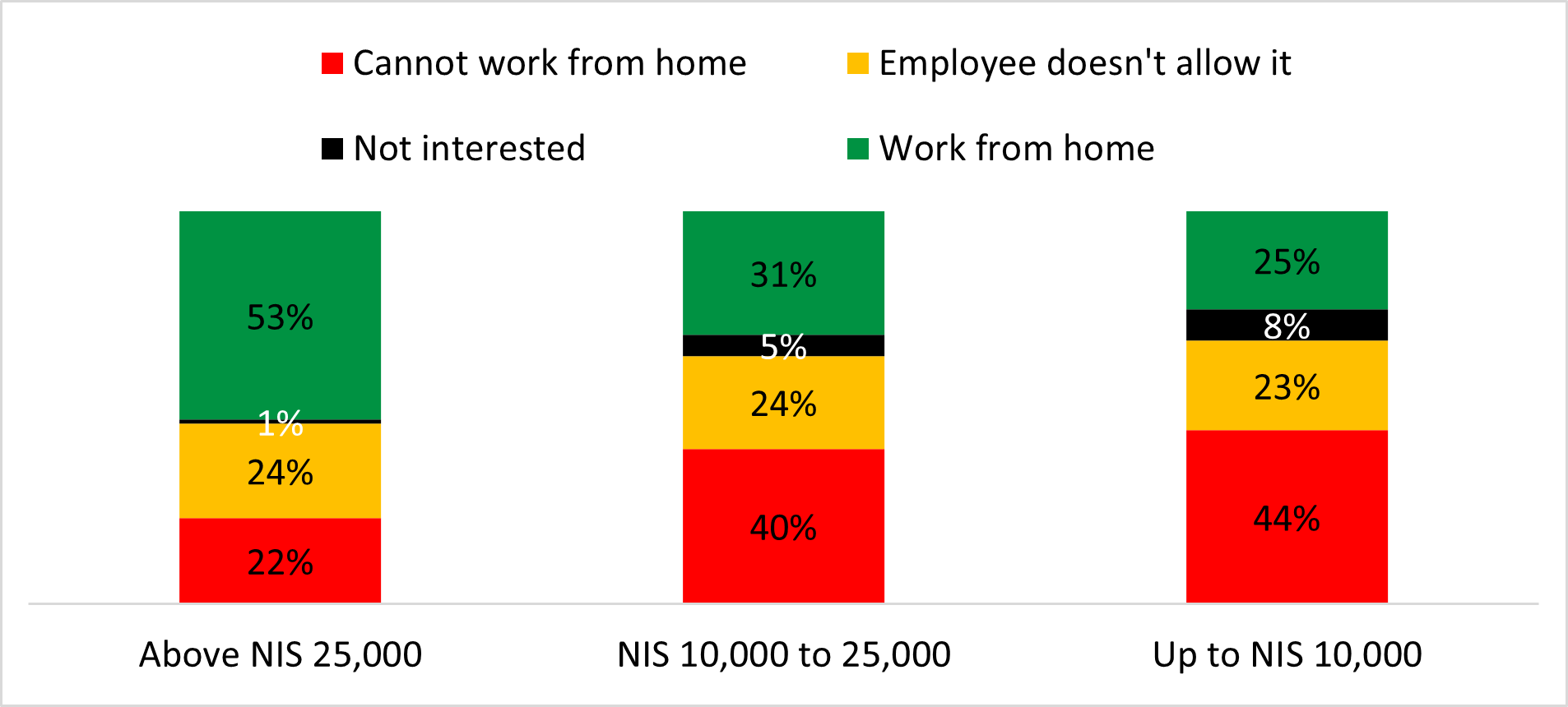
As can be seen in figure 17 below, the proportion of employees working from home is largest in the high-tech sector (69%), due not only to the low percentage of workers in that sector who cannot work from home (20%), but also to the low percentage who report that their employer does not allow them to work from home (9%).
Figure 17. Work from home and interested in working from home (salaried workers aged 25–64, by industry sector; %)
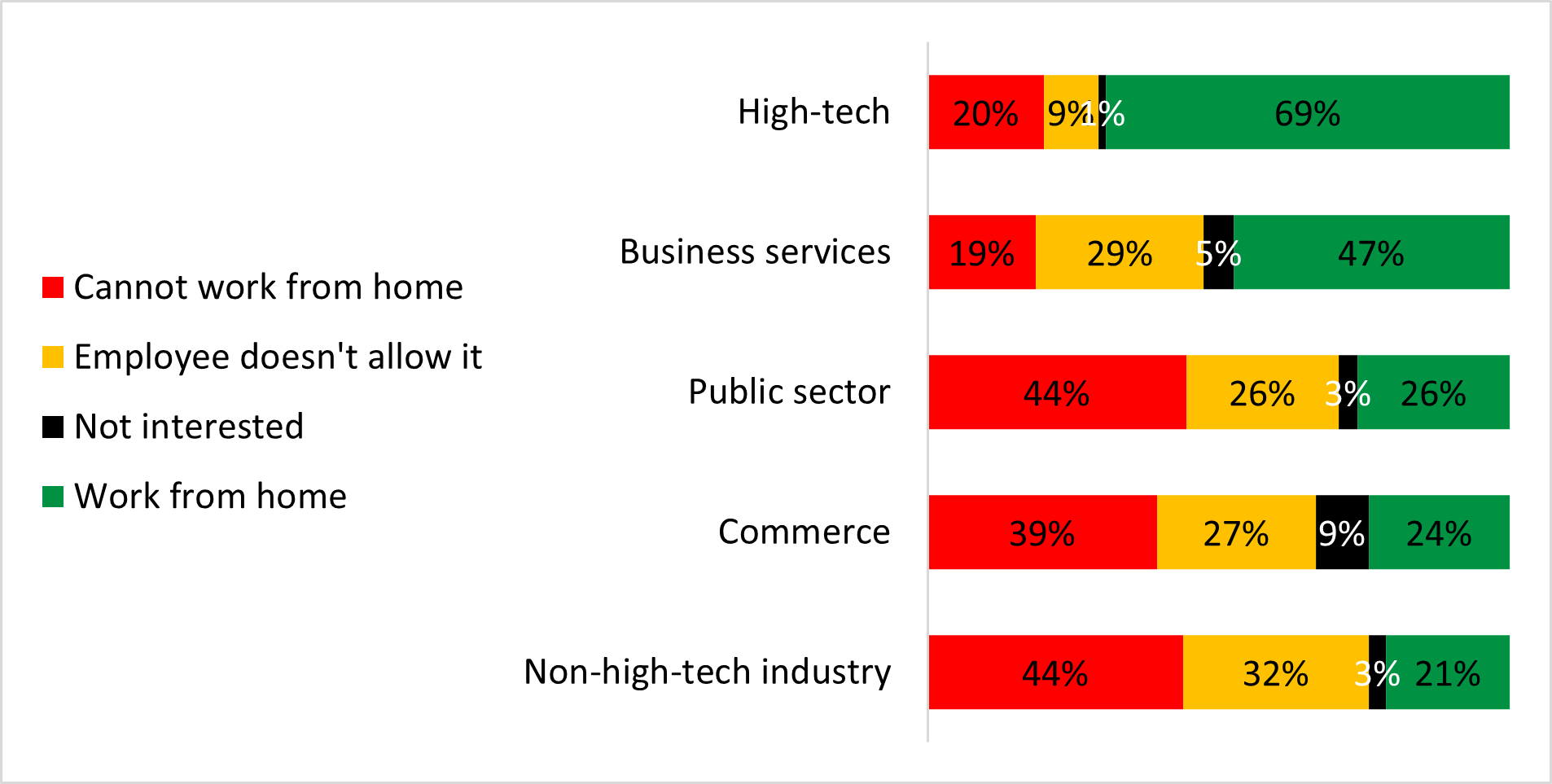
Worker Preferences Versus Current Situation
As presented above, the current situation is not aligned with workers’ preferences regarding the number of days they would like to work from home: The large majority of salaried employees (76%) are interested in working from home at least one day a week, while in practice, only 35% actually do so at present. Conversely, only 24% of employees would prefer not to work from home, while currently 65% do not work from home.
The survey examined workers’ estimates of their division of time between actual work, non-work conversations with colleagues, and personal matters. The large majority of work time in the office is dedicated to work (79%), with around 11% spent on non-work conversations with colleagues and another 10% on personal matters. According to the respondents’ self-assessments, there is no substantial difference in the proportion of time spent on actual work whether working from home or in the office (see figure 18 below).
However, we found that respondents reported spending more time on personal matters when working from home (14%) than when in the workplace (10%). Though not large, this difference is statistically significant.
Thus when working from home, time given to personal matters during work hours comes at the expense of conversations with colleagues: Only 8% of time is spent on conversations with colleagues when working from home, compared with around 11% when working in the office.
Figure 18. Division of time when working from home and in the office, self-assessment (salaried workers; %)
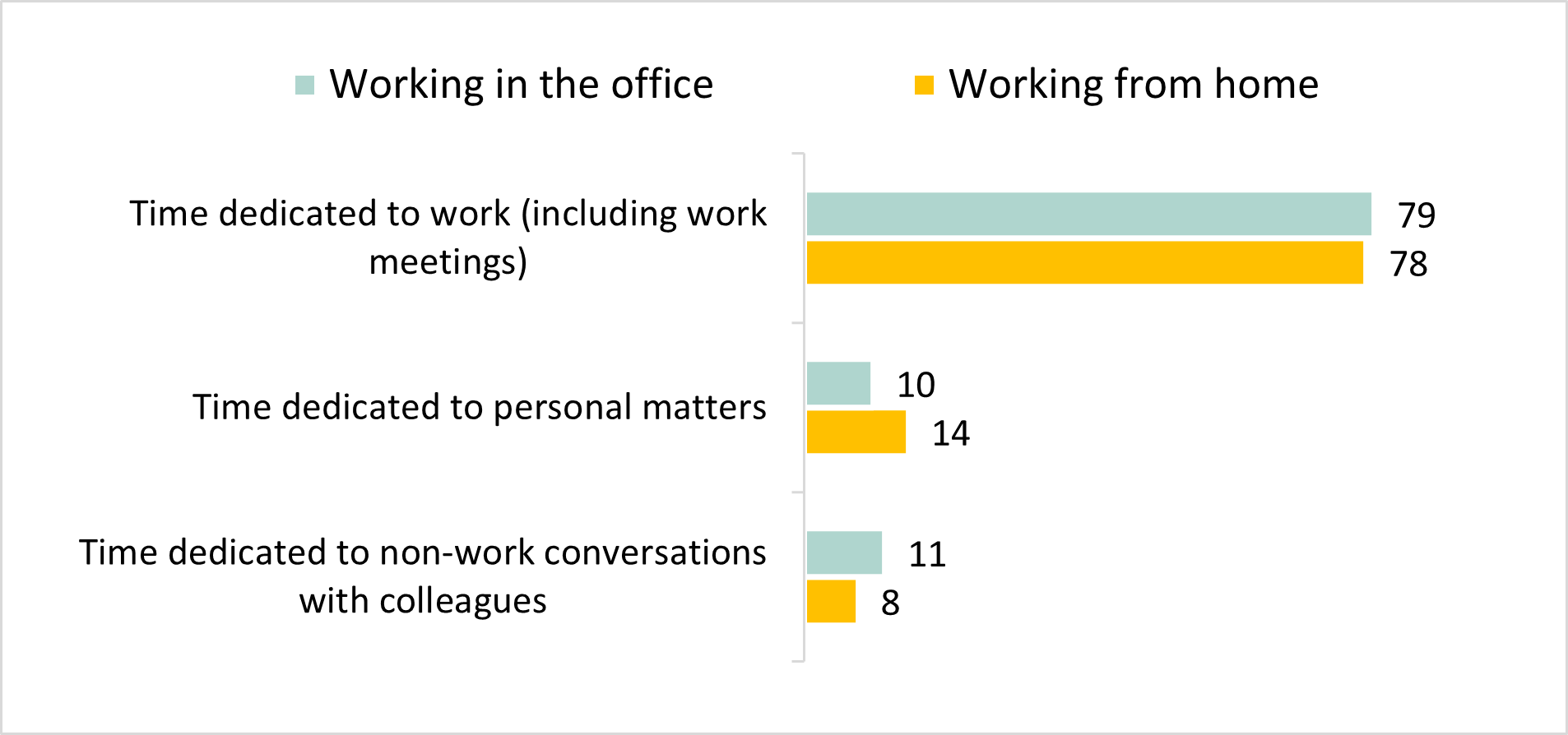
Further, the survey found that the vast majority of salaried employees (79%) say that non-work conversations (not held as part of a formal work meeting) are helpful for their work, with 49% reporting that they are extremely helpful (see figure 19 below). As noted above, when working from home only 8% of time is given over to such conversations, compared with 11% when in the workplace. Because conversations with colleagues are considered so useful, it is therefore possible that this reduction in conversation time with colleagues leads to reduced effectiveness of working from home, even though the amount of time spent on actual work in the workplace and at home is identical.
Figure 19. To what extent are non-work conversations with colleagues helpful for your work? (salaried workers; %)
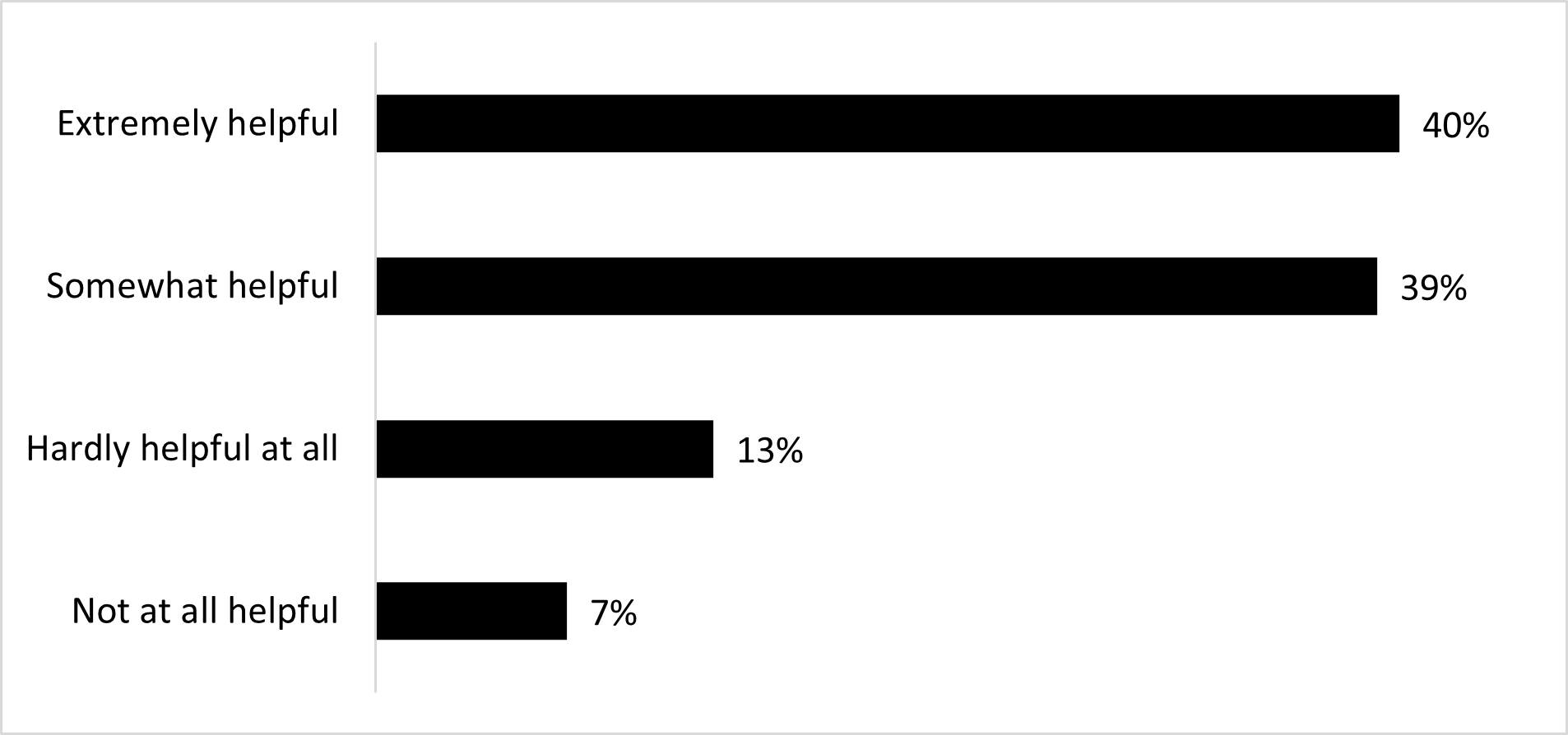
More than half (55%) of salaried employees who work from home report that they carry out their work during official working hours, while a relatively large share (around 45%) spread out their work at home throughout the day. This finding may indicate the flexibility of those working from home to set their own division of time between work and leisure and family life, as well as the advantages of working from home in improving work-life balance. This is in addition to the advantages provided by savings in travel time and costs and by lower pollution.
This finding is in line with the proportion of workers who say they are satisfied with their work-life balance: Around 65% of those who work at least one day a week from home report being satisfied in this regard, compared with just 58% of those who do not work from home.
Moreover, of the salaried employees who say that their work from home is conducted mainly during official working hours, 59% are satisfied with their work-life balance—similar to salaried employees who do not work from home (58%). By contrast, satisfaction with work-life balance climbs sharply to 73% among those who say that they spread out their work hours throughout the day (see figure 20 below). That is, when employees who work from home stick to official working hours, the positive difference in satisfaction relative to employees who do not work from home is erased.
Figure 20. Satisfied or very satisfied with their work-life balance (salaried workers in main working age groups, by distribution of hours worked from home; %)
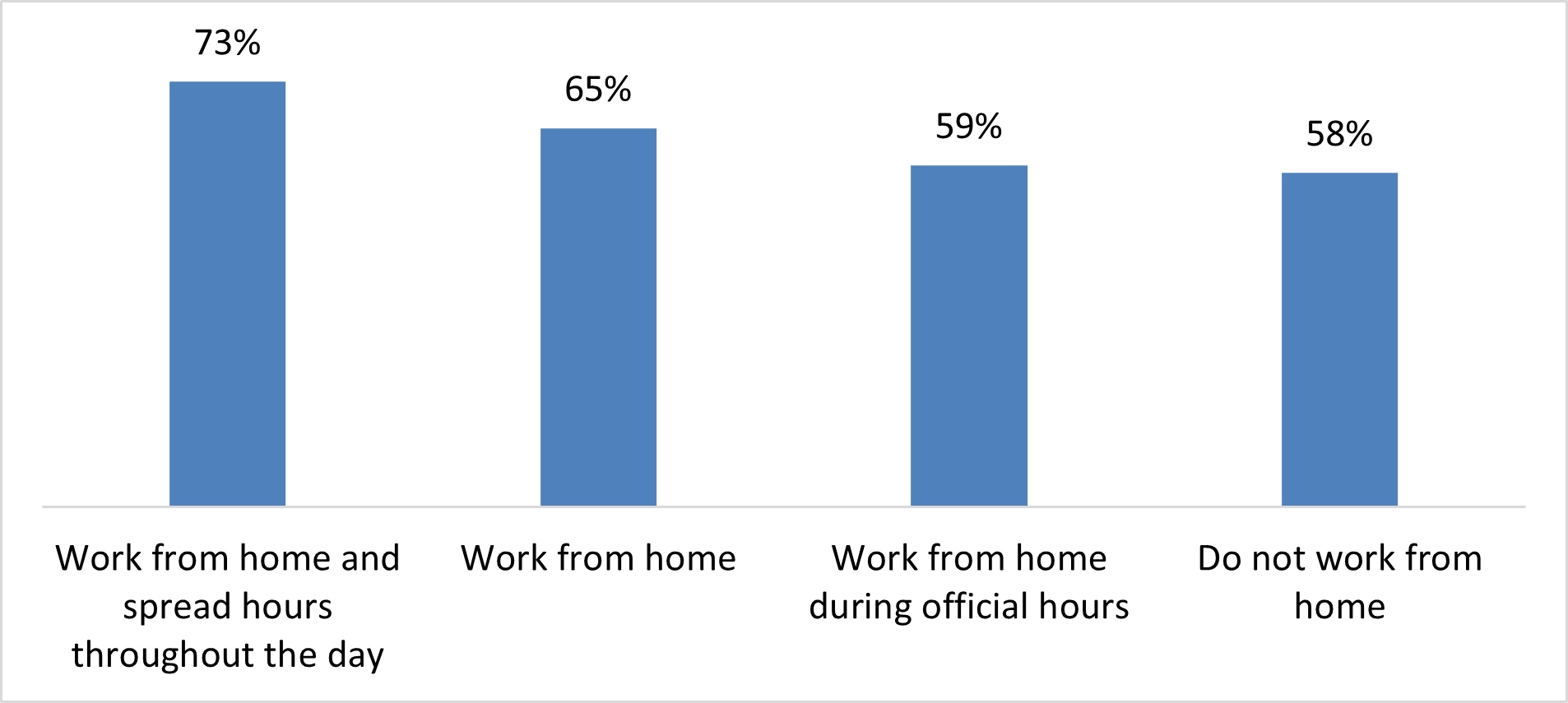
Breaking down responses by gender, while we noted earlier that a similar proportion of men and of women work from home, the proportion of women who work only during official hours (64%) is higher than that of men (48%).
In closing, we presented the survey respondents (both salaried and self-employed) with data relating to the length of the working week in Israel and in the OECD, according to which the working week stands at 42 hours in Israel, compared with 40 hours across all the developed countries and 37 hours in the European Union. We then asked them whether they think the working week should be shortened. Their responses reveal that there is broad support in Israel for a reduction in hours worked, with 67% of workers in the main working age groups in favor (around 72% of salaried workers, compared with just 40% of self-employed workers).
Figure 21. Think that the working week should be made shorter (workers in main working age groups, by employment status; %)

***
The survey was conducted by CI Marketing Information between February 2 and February 12, 2023. The survey sample comprised 760 respondents (79 self-employed and 681 salaried employees), constituting a representative sample of the population of workers in Israel.
